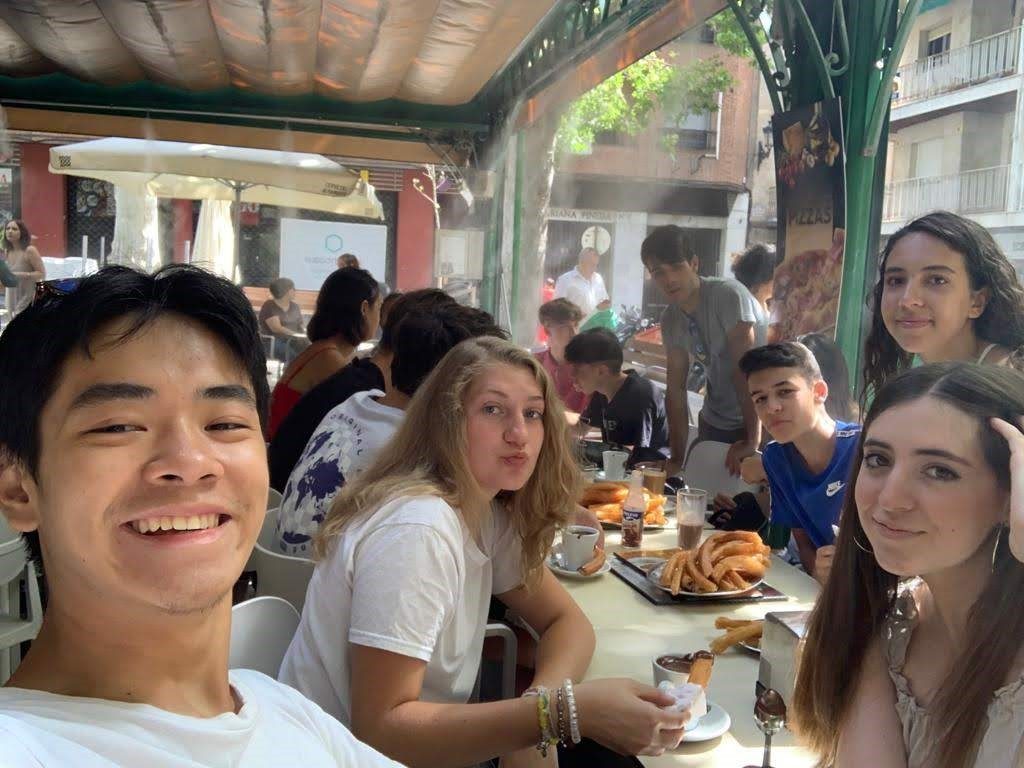Nervous to Stay, Reluctant to Go
A Reflection on the Homestay Experience in Granada, Spain by Ana Underberg
This past week has been incredibly memorable. Before meeting my homestay family, I was so nervous that I wanted to jump out of the bus window on the way to Granada and hide. But when I got off the bus and entered the giant mess of people trying to find their host families, I didn’t feel alone in my nerves or excitement.
I saw and experienced so much this week that I can hardly recall it all: parties, home cooked foods, beaches, pools, new places, new cultures, and total immersion into Spanish life. That is what awaits you in your homestay. An added bonus was that all of the Americans and Spaniards got along very well, so we ended up becoming one giant family of friends.
As I sit here now reflecting, I have realized, though it is corny, that the hardest thing wasn’t meeting my family or going to their home as a stranger; it was leaving them as a sister.

Students Ben and Claire (left) enjoying churros with their host siblings
Como Granada, No HayNada
A Description of Activities from our Week in Granada, Spain by leader Vanessa Wyns
Granada is a city unlike many others. At the start of one street you may find Moroccan cafes with richly decorated interiors and the sweetest mint tea you’ve ever tested, while at the street’s end you may find yourself in a small cobblestone plaza enjoying the view of the white-washed hillside Albaicín neighborhood (a UNESCO World Heritage Site), to the tune of flamenco guitar music being casually played by a man relaxing on his stoop during the siesta hour. Granada, a city with imprints of Jewish, Muslim, and Christian influence, and located at the base of the Sierra Nevadas just one hour away from some of Spain’s finest beaches, truly has a little bit of everything.
The Moorish influence on this city, the last to fall during the Catholic Kings’ “re”-conquering of Spain, remains palpable to this day. We learned this when walking through the Alcaicería – a series of streets that formerly made up the Great Bazaar, where Arabic silks, spices, and goods were traded. Filled nowadays with small stores bursting with new and old treasures, it still pays homage to its heritage as a merchant hub. We explored the small, windy streets with their multitudes of stores, just as people would have done in the 14th century, when the Alcaicería was newly constructed. Our guided tour of the Alhambra gave us more historical context yet, as we learned how it was originally built by an Islamic emir in the mid-13th century, and later converted into a royal palace by Yusuf I, Sultan of Granada, nearly a century later. After touring the Alhambra and its gardens, we enjoyed a dinner at one of Granada’s most desired restaurants situated atop a hill opposite the Alhambra: el Restaurante Mirador del Morayma. From this privileged vantage point, and over an appetizer of braised asparagus wrapped in cured Spanish ham, we saw the sunset cast a red glow over the Alhambra, which is how the palace got its name. Alhambra derives from the Arabic for “the red castle.”
Other highlights of this week included seeing a flamenco show in Granada’s gypsy quarter high on the hill of Sacromonte, spending a day at the beach with our host siblings in Nerja, and learning about the artistic and architectural periods that are represented throughout the city at the Museum of Andalucía. After all that our host families have done for us this week, we really enjoyed being able to share our gratitude for them during the Farewell Dinner, where we all recited letters of thanks in Spanish to our families one by one. Our week concluded with a day visit to a stunning reservoir and river called El Charcón, where we got to enjoy one last day with our host siblings hiking, eating fresh figs, and swimming in a cool river.
 The group touring the Alhambra
The group touring the Alhambra  The Alcaicería market stalls
The Alcaicería market stalls

Students Mary Hayes and Grace enjoying the beach at Nerja
 Flamenco performance in Sacromonte
Flamenco performance in Sacromonte
 Happy to be coming down the hill after the Alhambra tour
Happy to be coming down the hill after the Alhambra tour


